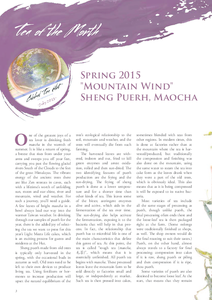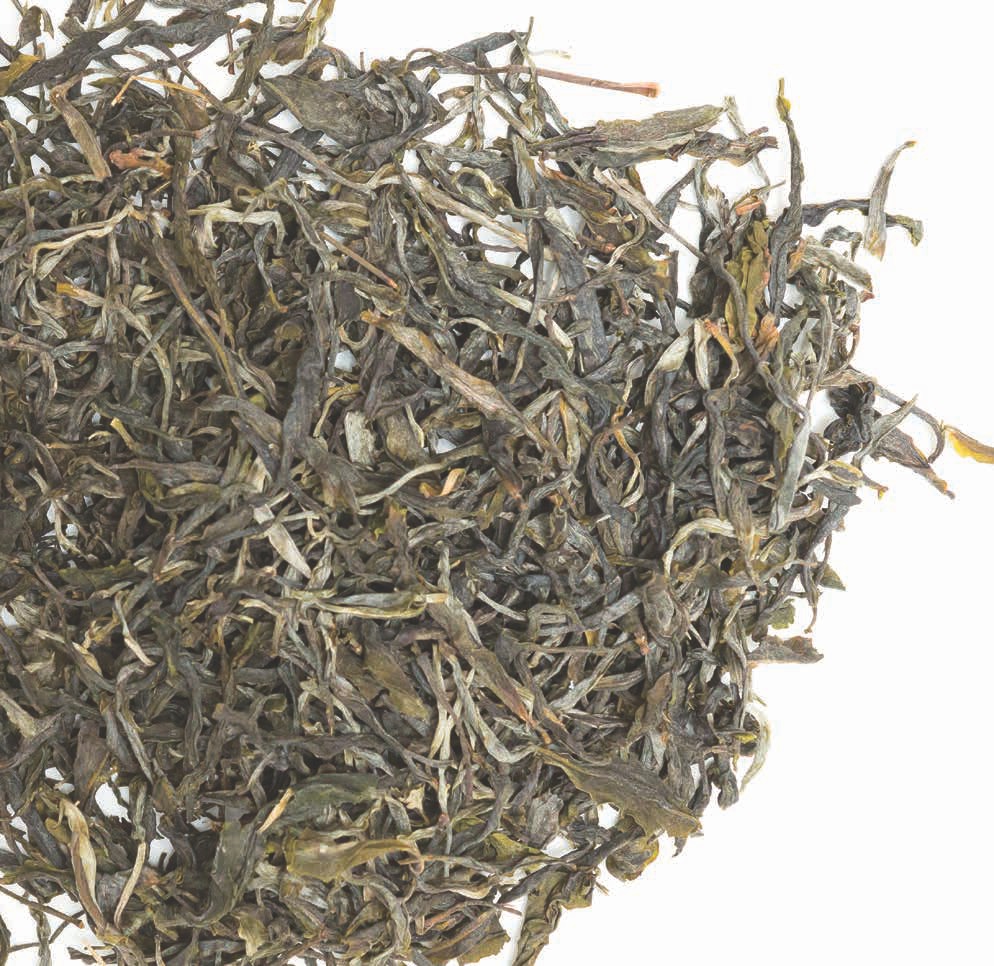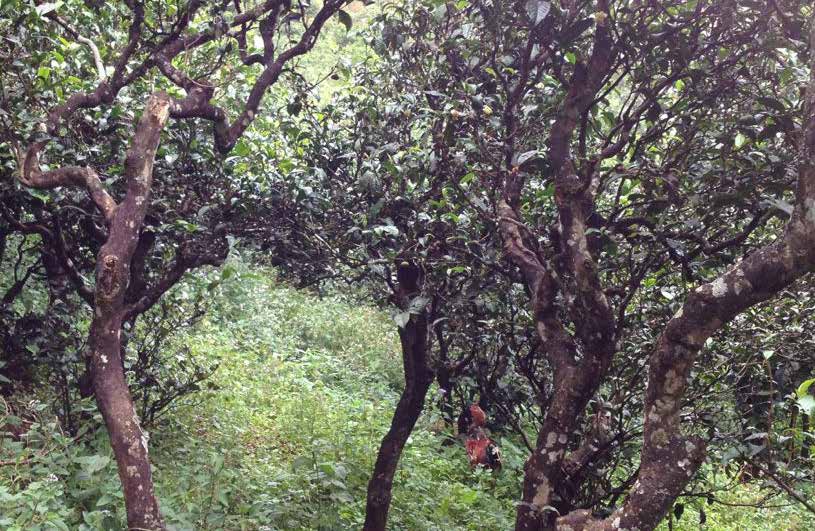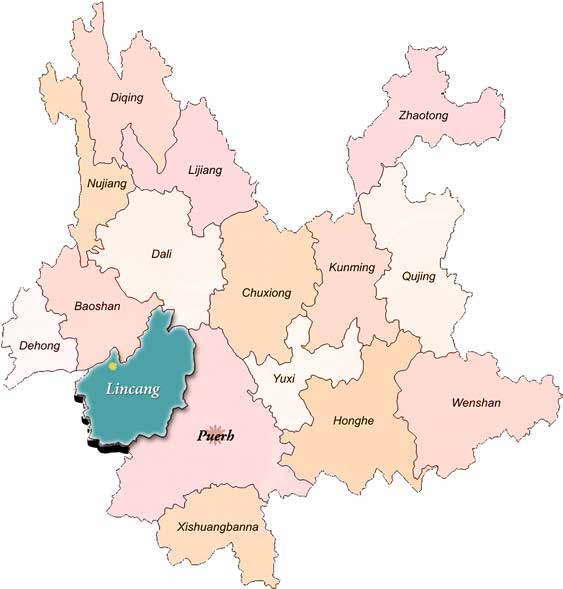
 |
|

 | "Mountain Wind" (山 之 風) |  | Da Hu Sai, Lincang, Yunnan |  | Sheng Puerh, Maocha |  | Wa Aboriginal Tribe |  | ~2000 Meters |

One of the greatest joys of a tea lover is drinking fresh maocha in the warmth of summer. It is like a return of spring, a breeze that rises from under your arms and sweeps you off your feet, carrying you past the flowing glacial rivers South of the Clouds to the feet of the great Himalayas. The vibrant energy of the ancient trees there are like Zen retreats in caves, each with a lifetime's worth of unfolding sun, moon and star shine, river and mountain, wind and weather. For such a journey, you'll need a guide. A few leaves of bright maocha in a bowl always lead our way into the warmer Taiwan weather. In drinking through our samples of puerh for the year, there is the added joy of selecting the tea we want to press for this year's Light Meets Life cakes, which is an exciting process for guests and residents at the Hut.
Sheng puerh made from old trees is typically only harvested in the spring, with the occasional buds in autumn as well. Old trees need to be left to their own devices to produce living tea. Using fertilizers or hormones to increase production will upset the natural equilibrium of the tree's ecological relationship to the soil, mountain and weather, and the trees will eventually die from such farming.
The harvested leaves are withered, indoors and out, fried to kill green enzymes and arrest oxidation, rolled and then sun-dried. The two identifying features of puerh production are the frying and the sun-drying. The frying of sheng puerh is done at a lower temperature and for a shorter time than other kinds of tea. This leaves some of the bitter, astringent enzymes alive and active, which aids in the fermentation of the tea over time. The sun-drying also helps activate the fermentation, exposing it to the bacteria that will help in that process. In fact, the relationship that puerh has to microbial life is one of the main characteristics that define this genre of tea. At this point, the tea is called "rough tea (maocha, 毛茶)", which means that it is essentially unfinished. All puerh tea begins with maocha. These processed leaves leave the mountain farm to be sold directly to factories small and large, or independently at market. Such tea is then pressed into cakes, sometimes blended with teas from other regions. In modern times, this is done at factories rather than at the mountain where the tea is harvested/produced, but traditionally the compression and finishing was also done on the mountain, using the same water to steam the tea into cake form as the leaves drank when they were a part of the old trees, which is obviously ideal. This also means that as it is being compressed it will be exposed to its native bacteria.
Most varieties of tea include all the same stages of processing as puerh, though unlike puerh, the final processing often ends there and the loose-leaf tea is then packaged right at the farm. (Some oolongs were traditionally finished at shops, as well. The shop owners would do the final roasting to suit their tastes.) Puerh, on the other hand, almost always travels to a factory for final processing: compression into cakes if it is raw, sheng puerh or piling and then compression if it is ripe, shou puerh.
Some varieties of puerh are also destined to become loose leaf. At the start, that means that they remain maocha, but once they are aged, they are technically no longer "rough tea". So an aged, loose-leaf puerh shouldn't really be called "maocha".
Traditionally, these loose teas were the ones that were grown at smaller farms that didn't have contracts with any factory - often from so-called "Border Regions" where Yunnan meets Laos, Vietnam or Myanmar. Such teas were then sold at market, traded between farmers or bought and stored by collectors. You can't be certain, however, that a loose-leaf puerh is a Border Tea, as the big factories also packaged and sold some of their teas loose, though not as much as compressed tea. Although some of the tea that was sold loose was fine quality, most of it was considered inferior.
Puerh processing is a very old and simple methodology. Different genres of tea have different measures of quality based on a ratio of raw material to processing skill. Cliff Tea, like the one we sent last month, for example, is measured at least as much in the processing as it is in the trees/leaves. But puerh is different. With puerh, the quality is much more in the trees/leaves, with tea from older trees having more breadth, wisdom and medicinal juju. The tea's mountain, village and the age of the trees will all play a large role in the price and quality of a puerh. Because of that, there is a lot of confusion and dishonesty surrounding regions and age of trees in the puerh market, with young, plantation-tree tea (tai di cha, 台地茶) being mixed into old-growth raw material, or tea from one region being brought to another and sold under false pretenses. This means that you have to have some experience tasting teas, knowing if it is organic or not, young or old-growth and from which region (at least relatively). It also helps to have trusted sources like we do at the Hut.
Nowadays, there is also a lot of confusion about blended versus single-region tea, as well as what defines "old-growth" puerh. It is good to have some clarity on these issues, at least in terms of what we are writing about in the pages of Global Tea Hut. As for the first issue, there are great blended teas from the Masterpiece (1949-1972), Chi Tze (1972-1998) and Newborn (1998-present) eras of puerh. Sometimes, teas from different regions, or even the same region, enhance each other beautifully. All teas are technically blends, since different sides of the same tree will produce different leaves, let alone different parts of the same forest. Still, there is something to be said for single-region puerh, since that was the way that all puerh tea was traditionally produced. All the teas from the Antique Era (pre-1949) were single region. The terroir of a place, including the culture of how to process the tea will then be homogeneous. This includes the genetic heritage of the trees, the climate and soil, the microbial environment so important to the tea's fermentation, and ideally also the spiritual/cultural rituals that surround harvest and production. As for what we mean when we call a puerh "old-growth", for us it means that the tea leaves were harvested from trees that are at least one hundred years old. We think that when you start talking in centuries, it's definitely "oldgrowth".
When drinking fresh-from-thefarm maocha, there are many criteria for finding the right tea to make into cakes: you can drink with an eye towards aging the tea (in which case you will have to have a lot of experience drinking aged and aging teas at various stages), learning about regions, or creating cakes that can be enjoyed young. The best of teas will be great when young, middle-aged and vintage.
Key to Living Tea: seed-propagated, room to grow, biodiversity, no agrochemicals, relationship, no irrigation or fertilizer
Since many of you will want to explore sheng puerh on your own, drinking cakes and maocha, we thought that sharing a clean, chemical-free tea from a known source and region, and from old-growth trees, would be helpful to your journey through the amazing world of puerh. Such bright tea as this month's can therefore be so much more than enjoyment; it can also be the measure of a great young puerh. As we were searching for this year's sheng Light Meets Life cake, we had it narrowed down to three choices. This month's tea, called "Mountain Wind", was the runner-up this year. (You will have to wait a bit to learn more about the wonderful cake we are pressing right now.) It is, nonetheless, a wonderful tea in its own right. When we learned that we could get a large enough quantity of the maocha to send to you all, we were thrilled.

This tea is from the village of Da Hu Sai in Lincang. The leaves are harvested from 1-to 200-hundred-year-old trees, which means it is on the younger side of what we call "old-growth" puerh. The trees are all chemical-free, grown naturally in forest gardens with very little human intervention, which means that the tea is vibrant and healthy "living tea".



The Lincang region is the northernmost of the three major tea areas in Yunnan. It is also the birthplace of all tea. The forests there have the oldest trees, and deepest roots in Cha Dao. There is some disagreement amongst scholars as to the origin of tea, but in traveling to the three major areas of Yunnan, we have found that the Lincang region is the home of all Tea. We especially feel this in the "Five Mountains". Our understanding, however, is based more on a feeling, a connection and affinity to Tea and Her spirit than on any linear proof - take it or leave it... The five mountains all Tea originated from are:
There are many other tea-growing regions in Lincang, like the now famous Bing Dao. Tea from this area has only blessed the market in modern times, though the aboriginals have been drinking this tea for millennia. The tea here is strong and deep, with sun, moon, mountain and air pouring through it.
The Da Hu Sai village tea is strong but Yin. The liquor is thick, with astringency and bitterness, but a fast transformation that leaves a sweet aftertaste in the mouth. Such a flavor profile is often considered the ideal in young puerh - both for drinking now and for aging. The Yin energy is so full and brisk that it is on the verge of changing to Yang, like a woman late in her pregnancy, a raincloud about to burst, or that dark time just before the dawn. We find the energy very uplifting, cooling and yet so very Yin that we thought "Mountain Wind" to be the perfect name for this month's tea. We hope you find the perfect summer retreat to enjoy this amazing spring tea, sharing the spirit of the ancient forests of Yunnan with those you love.

Leaves like feathers in an old bowl The swirling waters stir A Himalayan wind That rises from under the arms Carrying away all but leaf-wings A silver spirit of the forest I now roll and billow over the trees Sometimes down to the forest f loor Twirling in ribbons around the plants and animals Everything pauses to look up at me I'm an honored guest And though we've broken our promises And betrayed them all There is still hope in silver spirit love
Mountain Wind is the most quintessential of all leaf-in-the-bowl teas, so we wouldn't want to suggest brewing it any other way! Even if you do decide to brew some of this tea gongfu or in a side-handle, please do yourself a favor and put a few leaves in a bowl. The summer is a great time to head outdoors for a session in Nature, and with such a cooling tea as company you will be rewarded with an amazing experience.
This tea will be more easily influenced by the water that you choose, as it is lighter, greener and more Yin. For that reason, you may want to save the extra-special spring water you have for a session of Mountain Wind. Reading through this month's issue, you will learn a lot about water for tea, much of which will help you to pair the best water with this month's tea. If you can, hike to a local spring and fetch some water for yourself. The added energy put into preparing this tea well will reward you with a transformative brew. This month's tea is truly medicine, and it is important that we begin to see our tea that way. Such a view can extend to the food we eat and the water we drink. As you enjoy this month's tea, and read all about water as an element in the alchemy of tea, cultivate a greater reverence for water, which is a fundamental part of your body and the bodies of those you love. In that way, we become more grateful for the water and tea we have, learning to celebrate the simple joys of being alive in this world.
Be sure to surround this month's tea with a bit more reverence, as it has traveled long and far from the source of all Tea to be with you. A bowl of fresh maocha on a summer afternoon is one of the greatest joys a tea lover can know, especially when the tea is from old-growth trees. These amazing leaves carry great energy from old mountain forests - an energy that rises from under you like the winds rolling down the Himalayas. Watching these amazing, juicy leaves open in some fresh water you gathered yourself, feeling the vibrant, airy, feminine Qi rise from under your arms in cooling billows and you may find yourself in another place...